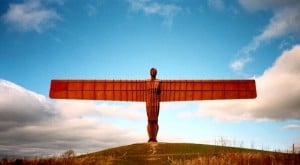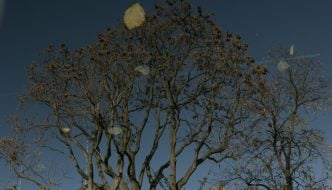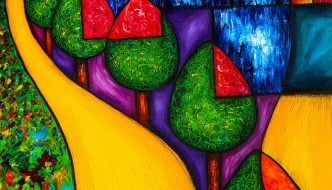Feature: Public Art and the University of Leeds
August 20, 2015
The Independent recently released a list of the top 21 Great British landmarks; it featured many of the nation’s favourite architectural triumphs, from the Tate Modern to St. Paul’s Cathedral and Chatsworth House. Residing closely alongside those impressive feats of architecture were some of the best public artworks this country has to offer. Antony Gormley’s iconic Angel of the North took second place, and Burnley’s Singing Ringing Tree also made the cut. On top of this, who could forget the success of Blood Swept Lands and Seas of Red, the 888,246 red ceramic poppies installed outside the Tower of London between July and November 2014 to commemorate 100 years since the start of World War One? The installation drew over five million visitors, and the poppies are currently making their way up North to our very own Yorkshire Sculpture Park for September 2015.

[Image: Antony Gormley, Angel Of The North, 1998 Photo Credit: www.picturesofgateshead.co.uk]
It seems strikingly obvious that the popularity of public art is growing exponentially. Public art has the ability to inspire, challenge, and reach a far wider audience than art-work contained within private collections or galleries.
Leeds is a city that holds public art and sculpture close to its heart. Birthplace of the infamous 20th century sculptor Henry Moore, and home to the Yorkshire Sculpture Triangle – which boasts the Henry Moore Institute, Leeds Art Gallery, Yorkshire Sculpture Park and the Hepworth Wakefield – the city is bursting with exciting artwork and cultural promise. The bid for 2023 European Capital of Culture has just been approved, and the British Art Show 8 is touring to Leeds Art Gallery for October.
With all these exciting cultural developments, and the longstanding relationship that the city shares with public art and sculpture, it is unsurprising that the cities top educational hub, The University of Leeds, wants to harbour its own cultural power to invest in and promote public art for students and the community alike.
In 1951, Henry Moore wrote that ‘Sculpture is an art of the open air’ and that is precisely what the initial part of the University’s public art strategy, the Curating the Campus public art trail, hopes to highlight. The unveiling of the trail, which has a map and smartphone app, signalled the start of a series of public events aimed at promoting the accessibility of and showcasing the University’s diverse collection of public art.
One highlight of the collection is Mitzi Cunliffes Man-Made Fibres, a carved wall relief depicting a pair of hands with textile fibres crossed between them. Keith Wilson’s Sign for Art is also an intriguing addition to the collection. Affectionately known as “the squiggle”, the piece references Wilson’s early years working as an art instructor for deaf-blind adults in the 1980s. The latest commission by Simon Fujiwara outside the new Laidlaw Library is also perfectly situated in encompassing what it means to be a student. From its title (“A Spire”), to its many historical, contextual and material references, it embodies the collaborative, research learning style you develop at university.

[Image: Keith Wilson Sign for Art (Stelae 2014) Photo Credit: B.P.M. Harris]
At the helm of the University’s public art strategy is newly-appointed public art project officer Professor Ann Sumner, who has extensive art gallery experience within the university sector and is an established academic within the field. I spoke with her to find out more about the project and where it’s headed.
TSOTA: Why do you think public art has become so popular in recent years, and what do you hope to achieve by raising the profile of public art on campus at Leeds?
AS: Public art has become increasingly popular in Britain since the success of iconic artworks such as Anthony Gormley’s Angel of the North, the interventions on the Fourth Plinth in Trafalgar Square, London and the great popularity of the Yorkshire Sculpture Park. Public art encourages audiences to think and respond not only to historical issues but key places and emotions. At the University of Leeds we are eager to encourage new audiences to campus to appreciate the artwork on display here such as Eric Gill’s famous First World War memorial Christ chasing the Moneychangers from the Temple (1923) or Mitzi Cunliffe’s iconic Man-Made Fibres sculpture of 1956, which is situated high on the Clothworkers South building and is often somewhat overlooked. Next year Cunliffe’s giant hands and threads celebrate their 60th birthday and we hope to draw attention to this extraordinary American sculptor and revive her legacy in this country. We hope that new commissions on campus will also draw audiences here to appreciate the artwork on view. The aim of the programme was to engage new audiences and to encourage people to look anew at works of art and appreciate them in a new light. Our feedback suggests that this is happening! The new interpretation is proving popular with the public.
TSOTA: How important is accessibility in the art world for you?
AS: It is very important to us. The Stanley & Audrey Burton Gallery is free for all and we have ensured that the Public Art Trail leaflets are available outside the gallery even when it is shut. Audience Development is crucial for us as we look to engage with our own communities at the university, the students, staff and alumni and the wider communities beyond campus. We have introduced the literary theme this year and have encouraged audiences to respond themselves creatively to our artworks, submitting their own poems. We have been thrilled with the results, with passers-by on the bus sending in their poems as well as those who have known sculptures for many years and not realised their significance. People come anew to works of art via many routes – the recent BBC series Life in Squares about the Bloomsbury artists generated more interest in Bell’s The Dreamer than we usually have experienced.
TSOTA: Why did you choose Place-Making as the theme for this year?
AS: Outdoor sculpture plays a key role in Place-Making – for instance on a university campus graduation photographs are often taken by a famous statue or fountain. With new sculpture by Wilson and Fujiwara situated in key locations on campus and the re-location of Bell’s The Dreamer, siting of the Austin Wright, following a major new approach to our campus, creating new pedestrianised plaza areas, it seemed the right moment to look at how our public art contributes to the sense of place-making here.
TSOTA: Do you have a favourite piece of public art?
AS: Austin Wright’s Limbo, I first came across Austin Wright’s work when I was Head of Fine Art at the National Museum of Wales from 2000 – 2007. There we acquired a work called News in 2002 and in 2006 a series of lead Limbo figures were donated by Lisbeth David. I remember reading James Hamilton’s excellent book The Sculpture of Austin Wright and being enormously impressed by Wright’s sculpture and then seeing the York exhibition in 2011. So I was delighted, when I arrived here at the University of Leeds, to hear that Wright’s subtle work Limbo of 1958 had recently been presented by the Austin Wright Trust through the Art Fund and installed in the Baines Wing Coffee Bar.
The work is inspired by family seaside holidays in Anglesey and Cornwall in the 1950s and the figures in this piece relate to sketches made at Praa, a long sandy stretch of beach between the Lizard and West Penwith in South West Cornwall. It reminded me at once of my own family holidays on that same beach in the 1960s, often sheltering in the dunes to avoid the wind!

[Image: Austin Wright, Limbo, 1958 Photo Credit: University of Leeds ©]
TSOTA: This is an exciting year for Leeds, with the recent bid for European capital of culture, and the British Art Show 8 coming to Leeds in October. Will you be planning events to coincide with the British Art Show?
AS: The themed approaches to campus curation will assist with our co-ordinated planning going forward for the City of Culture bid. Next year we are looking at Textiles as a theme on campus and beyond for partnerships with artistic interventions, celebrating the Man-Made Fibres sculpture. We will hopefully be working with textile artist Sue Lawty in the future.
Find out more at the dedicated public art page on UoL’s library website.
Alice Chandler
Filed under: Art & Photography, Written & Spoken Word
Tagged with: a spire, ann sumner, anthony gormley, art, austin wright, fourth plinth, grove plaza, keith wilson, laidlaw library, leeds, man-made fibres, mitzi cunliffe, of, public art, sign for art, simon fujiwara, the squiggle, university, UoL



Comments